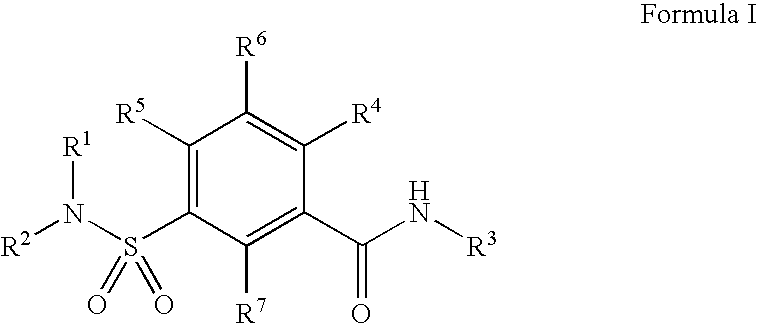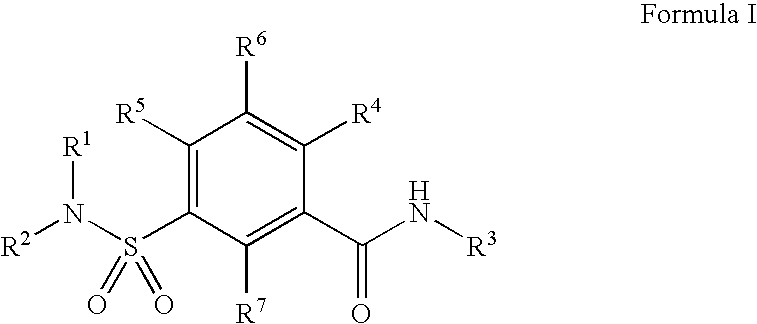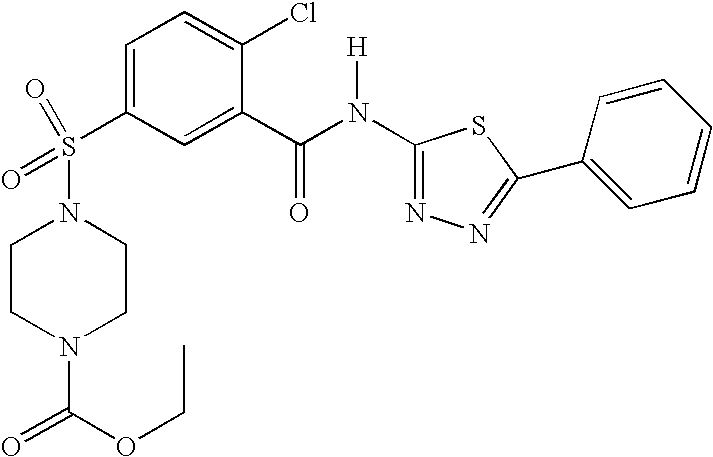Compounds, compositions and methods
a technology of sulfonamide and derivatives, applied in the field of substituting sulfonamide derivatives, can solve the problems of dilated and hypocontractile hearts, heart failure, and decreased contractility and relaxation ability
- Summary
- Abstract
- Description
- Claims
- Application Information
AI Technical Summary
Benefits of technology
Problems solved by technology
Method used
Image
Examples
example 1
[0168]
Preparation of 4-(3-Carboxy-4-chloro-benzenesulfonyl)-piperazine-1-carboxylic acid ethyl ester
[0169] 2-Chloro-5-fluorosulfonylbenzoic acid (Acros Organics, 105 mg, 440 μmol, 1.0 eq) was placed in a vial and the vial was flushed with nitrogen and a positive pressure was maintained. Anhydrous dichloromethane (1.4 mL) was added, followed by ethyl 1-piperazine carboxylate (80 μL, 528 μmol, 1.2 eq) and ethyldiisopropylamine (redistilled, 80 μL, 440 μmol, 1.0 eq). The mixture was stirred for 1.5 h after which time additional piperazine was added (60 μL, 352 μmol, 0.8 eq). After 14 h the mixture was analyzed by reverse-phase HPLC-MS in negative ionization mode. The sulfonyl fluoride starting material was present, as well as a less polar compound showing (M−1) ion in about 35:65 ratio. An additional 0.35 eq of piperazine and ethyldiisopropylamine each (154 μmol, 30 μl) were added and the mixture was stirred for 4 h. HPLC-MS at this time indicated little progress and an additional 0.2...
example 2
Preparation of 4-(3-Carboxy-4-chloro-benzenesulfonyl)-piperazine-1-carboxylic acid tert-butyl ester
[0171] Prepared as for the compound above with these modifications: after the addition of 2.0 eq total of tert-butyl 1-piperazine carboxylate on day 1, HPLC-MS analysis showed the reaction to be only ⅓ complete. An additional 1.4 eq of piperazine was added and the reaction was stirred for 24 h. After this time the reaction was found to be complete and the workup was performed as for the ethyl case. Instead of washing with 1 M HCl solution, 0.3M potassium hydrogen sulfate solution was used and a wash with saturated sodium chloride solution was also added prior to drying and concentrating. A quantitative yield of desired product was obtained.
Preparation of 4-[4-Chloro-3-(1H-imidazol-2-ylcarbamoyl)-benzenesulfonyl]-piperazine-1-carboxylic acid tert-butyl ester
[0172] The benzoic acid piperazine tert-butyl ester from above (1.57 g, 3.88 mmol, 1.0 eq) was placed in a 100 mL round-bottom f...
example 3
[0176]
Preparation of 4-[4-Chloro-3-(1H-imidazol-2-ylcarbamoyl)-benzenesulfonyl]-N-cyano-piperazine-1-carboximidic acid phenyl ester
[0177] The Boc-piperazine imidazole compound from above (2.04 g, 4.33 mmol, 1.0 eq) was treated with 50:49:1 trifluoroacetic acid / dichloromethane / triethylsilane as described above for the cyclohexyl acetamide compound. The residue was treated with saturated sodium bicarbonate solution until pH>8, then the solution was extracted with EtOAc and concentrated in vacuo to afford 1.6 g free amine. Diphenylcyanocarbonimidate (1.08 g, 4.54 mmol, 10.5 eq) was added to the flask and it was capped, flushed with nitrogen and a positive pressure was maintained. Anhydrous THF (30 mL) was added, followed by ethyldiisopropylamine (redistilled, 830 μL, 4.76 mmol, 1.1 eq) and the mixture was stirred for 1 h. Analysis by reverse-phase HPLC-MS in positive mode indicated that the very polar unprotected piperazine starting material had been consumed and replaced with a compo...
PUM
 Login to View More
Login to View More Abstract
Description
Claims
Application Information
 Login to View More
Login to View More - R&D
- Intellectual Property
- Life Sciences
- Materials
- Tech Scout
- Unparalleled Data Quality
- Higher Quality Content
- 60% Fewer Hallucinations
Browse by: Latest US Patents, China's latest patents, Technical Efficacy Thesaurus, Application Domain, Technology Topic, Popular Technical Reports.
© 2025 PatSnap. All rights reserved.Legal|Privacy policy|Modern Slavery Act Transparency Statement|Sitemap|About US| Contact US: help@patsnap.com



